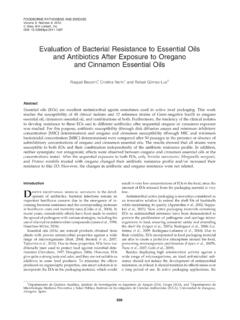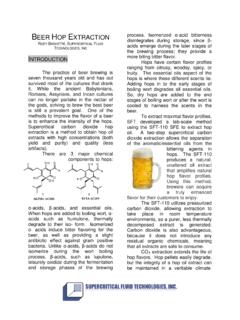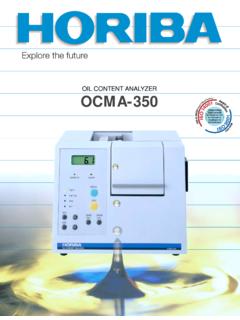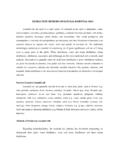Transcription of 'Comparison of Extraction Methods for the Rapid ...
1 J. AMER. SOC H ORT. SCI. 115(3):458-462. 1990. comparison of Extraction Methods for the Rapid Determination of Essential Oil Content and Composition of Basil Denys J. Charles and James E. Simon Department of Horticulture, Purdue University, West Lafayette, IN 47907. Additional index words. solvent Extraction , hydrodistillation, steam distillation, terpenes, Ocimum basilicum, Ocimum kilimandscharicum, Ocimum micranthum Abstract. Essential oils were extracted from leaves, flowers, and stems of Ocimum basilicurn, O. kilimandscharicum, and O. micranthum by solvent Extraction , hydrodistillation, and steam distillation for essential oil content and the oil analyzed by GC and GC/MS for composition. While the yield of essential oil was consistently higher from steam distillation than hydrodistillation, a similar number of compounds was recovered from both hydrodistillation and steam distillation. Though the relative concentration of the major constituents was similar by both Methods , the absolute amounts were higher with steam distillation.
2 Essential oil content and composition varied by plant species and plant part. Essential oil content was highest in flowers for O. basilicum and in leaves for O. micranthum. No significant differences were observed in essential oil yield and relative concentration of major constituents using fresh or dry samples and using samples from 75 g to 10 g of dry plant tissue. While minor differences between hydrodis- tillation and steam distillation were observed, both Methods resulted in high yields and good recovery of essential oil constituents. Hydrodistillation is a more- Rapid and simpler technique than steam and permits the Extraction of essential oil where steam is not accessible. Essential oils are a diverse group of natural products that are essential oils in aromatic plants. Important contributions have important sources of aromatic and flavoring chemicals in food, already been made towards solving this problem. Godefroot et industrial, and pharmaceutical products.
3 Essential oils are largely al. (1981) described a modified Likens and Nickerson apparatus composed of terpenes and aromatic polypropanoid compounds (1964) in which the volatiles are collected in only 1 ml of sol- derived from the acetate-mevalonic acid and the shikimic acid vent during continuous steam distillation and Extraction . One to pathways, respectively. Essential oil composition of plants var- 15 g of plant material, the amount depending on the content of ies and is due to genetic and environmental factors that influence essential oil, are required, and a complete analysis, including genetic expression (Bernath, 1986). The essential oil content of gas chromatographic separation, can be performed in less than plant tissue also varies with developmental stage (Burbott and 4 hr. Another micro-scale apparatus for steam distillation has Loomis, 1967), and can vary by Extraction Methods (Guenther, been developed by Bicchi et al. (1983) in which very small 1972).
4 Amounts of plant material (1 g) are required. The complete analysis Techniques commonly employed for extracting essential oils takes about 2 hr. However, the apparatus used in these Methods include hydrodistillation (ASTA, 1968), steam distillation (Chialva are expensive, limiting their usefulness for large numbers of et al., 1982), solvent Extraction (Burbott and Loomis, 1967), samples. Inferences on the yield of essential oil from such small head space analysis (Chialva et al., 1982), and liquid CO2 ex- amounts of plant tissue (one to two leaves) to the entire plant traction (Takeoka et al., 1985). The composition of the ex- or plant populations are also limited. tracted oil may vary from one Extraction method to another. In this paper, we compare the influences of three Extraction Head space analysis offers a potentially Rapid method to extract Methods -on measurements of essential oil content and compo- essential oils and requires very little plant material, but complete sition in various plant parts of Ocimum spp.
5 With the objective recovery occurs only for highly volatile materials (Takeoka et of developing a simple, Rapid , and reliable Extraction technique al., 1985). Steam distillation and solvent Extraction as conven- for this species in which the yield of essential oil can be accu- tionally applied result in severe losses of volatile materials be- rately determined. cause the liquid in which the oil is collected must be subsequently removed by evaporation (Burbott and Loomis, 1967; Chialva Materials and Methods et al., 1982). Solvent Extraction results in the recovery of non- volatile compounds (Burbott and Loomis, 1967). While liquid CO2 Extraction can give reliable and efficient recovery with little Plant material or no decompositional changes induced by the Extraction process, Ocimum basilicum L. (Harris-Moran Seed Co., Rochester, this process is expensive and used limitedly in commerce. More- ), O. kilimandscharicum (USDA Midwestern Regional Plant over, similar results can be obtained by hydro- or steam distil- Introduction Centers, Ames, Iowa), and O.
6 Micranthum Willd. lation (Kasting et al., 1972, Takeoka et al., 1985). (Companion Plants, Athens, Ohio) were field-grown at the Pur- Rapid techniques for extracting essential oils from relatively due Univ. Vegetable Research Farm (Lafayette, Ind.) during small amounts of plant tissue would be useful to characterize Summer 1987 and harvested while in full bloom in October. All above-ground portions were harvested and weighed, and the Received for publication 20 May 1988. Journal Paper no. 11,704, Purdue Univ. leaves, flowers, and stems were separated. Essential oils were Agr. Expt. Sta., West Lafayette, IN 47907. This research was supported by a then extracted from known weights (75 g dry weight or 200 g grant from the Purdue Univ. Agr. Expt. Sta. (Specialty Crops Grant no. 014- 1165-0000-65178). The cost publishing this paper was defrayed in part by fresh weight) of leaves, flowers, stems, or an equal mixture of the payment of page charges. Under postal regulations, this paper therefore leaves and flowers.
7 The samples were oven-dried at 30C for 3. must be hereby marked advertisement solely to indicate this fact. days to 1 week. In experiments where different sample amounts 458 J. Amer. Soc. Hort. Sci. 115(3):458-462. 1990. Table 1. Yield of essential oil from Ocimum basilicum, O. micranthum, and O. kilimandscharicum. Table 2. Essential oil composition from leaves of Ocimum basilicurn as affected by three Extraction Methods . z RT = retention time; HD = hydrodistillation; SD = steam distillation; OS = organic solvent Extraction . were used, the dry weights of the samples were 75, 20, 15, and material was ground in a mortar containing hexane and anhy- 10 g. drous Na2SO4 and extracted four times with hexane to give a total volume of 10 ml of yellow extract. A small amount of Essential oil Extraction Norit A charcoal, just sufficient to remove the yellow pigment, Essential oil was extracted from each of the plant parts by was added to each extract and then removed by centrifugation three Extraction Methods : at low speed.
8 The clear solutions were then concentrated under Hydrodistillation. Plant material was placed in a 2-liter round- a stream of air at room temperature. bottomed flask with distilled, deionized water (1000 ml for 75 Essential oil samples were stored in silica vials with teflon- g dry material and 400 ml for 200 g fresh material) and the sealed caps at 2C in the dark. The essential oil contents reported essential oil was extracted by water distillation using a modified are means of triplicate extractions. clevenger trap (ASTA, 1968). For smaller plant -samples, the amount of water was adjusted proportionally (1 g dry material Essential oil identification and quantification : ml water). The distillation period was 1 hr (fresh samples) Essential oil samples from each of the extractions were ana- and 1 hr 15 min (dried samples), and the essential oil content lyzed by gas chromatography (CC) using a Varian 3700 gas was determined on an oil volume to tissue weight (fresh/dry) chromatograph equipped with FID and a Varian electronic 4270.
9 Integrator (Varian, Walnut Creek, Calif.). A fused silica cap- Steam distillation. Steam distillation was carried out by pass- illary column (12 m mm ) with an OV 101 (Varian, ing steam into a 3-liter round-bottomed flask containing the polydimethylsiloxane) bonded phase was used to separate the dried or fresh plant material for 90 min and collecting the con- oil constituents. Direct injection of l of essential oil sam- densate (water and oil) in a round-bottomed flask. The conden- ples with helium as a carrier gas (100:1 split-vent ratio) and sate was extracted three times with ethyl ether to completely oven temperature held isothermal at 80C for 2 min and then extract the essential oil. Sodium Sulfate was added to the ethyl programmed to increase at 3C/min to 180C gave complete elu- ether to remove moisture. Ethyl ether was then removed by tion of all peaks (sensitivity 10-10). The injector and detector rotary evaporation and the essential oil content determined on temperatures were 180 and 300C, respectively.
10 Essential oil a volume to tissue weight (fresh/dry) basis. constituents were identified based on retention time and by co- Solvent Extraction . Solvent Extraction of essential oil was carr- injection with authentic compounds, and the relative peak area ied out by the method of Burbott and Loomis (1967). Plant for individual constituents was determined for each plant part. J. Amer. Soc. Hort. Sci. 115(3):458-462. 1990. 459. and organic solvent Extraction using three basil species and dif- ferent plant parts. The yield of essential oil from leaves, flow- ers, and stems of O. basilicum and O. micranthum and leaves and flowers from O. kilimandscharicum as extracted by steam and hydrodistillation is shown in Table 1. Preliminary studies indicated that organic solvent Extraction of essential oil for yield was difficult because essential oil losses occurred during solvent evaporation, and incomplete evaporation of the solvent could inflate the essential oil yield (data not shown).













